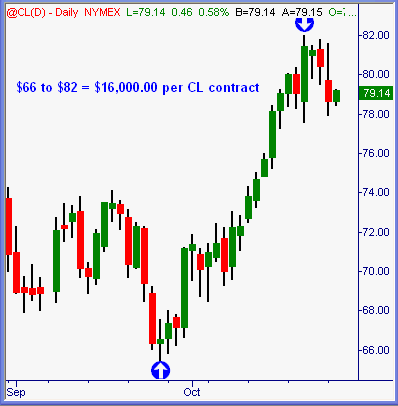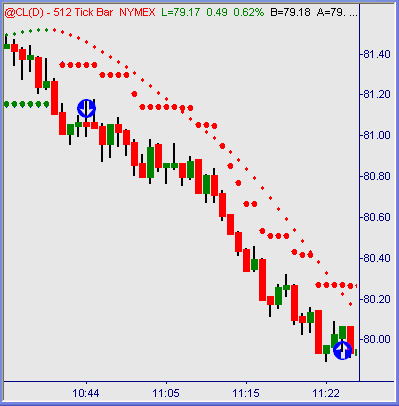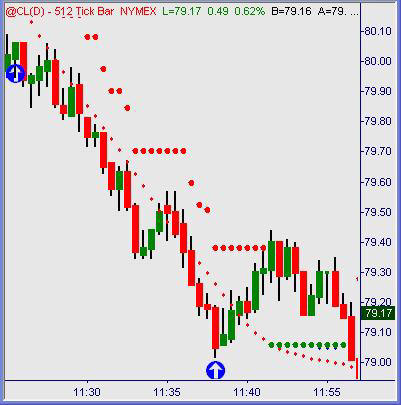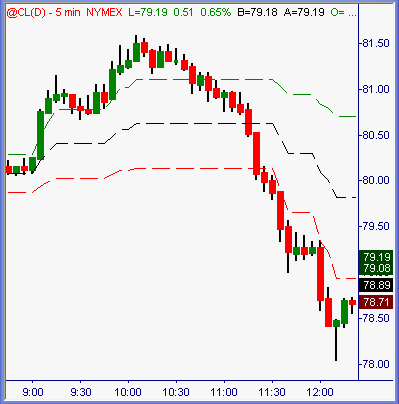If You Like Volatility Consider Trading This…
Oiled Up
For the past few years and counting, crude oil futures (CL) have gained increasing popularity and attention from individual traders for a number of good reasons. There was a time when the S&P 500 and/or Nasdaq 100 e-mini markets were known as the “wild west” show. I recall intraday ranges of 100+ NQ index points as common: ranges of 200 index points between the bells numerous times and a few days of 300+ index points from open to close are recorded in history. But that was nearly ten years ago. More recently we’ve seen dwindling volume and volatility across major stock indexes as the overall trend for 2009. Of course we can expect to enjoy periods of higher volume and volatility in equity markets as the endless cycles repeat themselves.
Chart 1

From the swing lows of late September through the end of October 2009, crude oil futures covered a price range of $16 in that stretch. At $1,000 per CL contract price change per $1 bbl price in the underlying oil, that’s a $16,000 per individual contract span. Comparable to the S&P 500 e-mini futures (ES) we’re talking what amounts to a +320 index point ascent. In reality, the ES had a price span of 80 index points swing low to high, or 1/4th the overall range that CL covered.
Chart 2

Chart 3

Furthermore, crude oil futures regularly cover 200% to 400% greater intraday price ranges than the ES does on average. A normal trading session in crude oil sees one to three or four +$1,000 per contract price swings… nothing unusual about that behavior at all. Compared to recent (lack of) volatility and range in e-mini index futures, it’s obvious where the momentum exists for traders to potentially exploit.
Chart 4

Sessions where directional swings = trend moves unfold will often see price ranges of $3,000 to $4,000 per single CL contract from peak to trough. Now it goes without saying that no one on earth is expected to or should expect to capture a majority of that. But isn’t it logistically easier to pull one or more +$500 per CL contract trades out of a $3,000 range than it is to somehow wrest +$500 ES swings out of a $525 total range for the entire day?
Liquidity
Home-based or “retail” day traders aren’t interested in any market that does not trade electronically with enough volume and open interest for enough liquidity to get in & out with minimal slippage. Of course the biggest markets like S&P 500 futures (ES) and Bond futures (ZB, ZN) have hundreds or thousands of contracts available at bid/offer on each strike. Some traders are leery of thinner markets with less volume and open interest due to the possibility of “slippage” on trade executions. This includes crude oil futures from that list.
But pure liquidity alone and/or the assurance of nil slippage aren’t the most important aspects of trading.
Too many traders fixate on “not-to-lose” instead of most favorable balance of profit-loss potential. It’s basic human nature to assume that loss-control = greater profit success. In the world of trading, that’s not true. Countless traders have in the past, are right now as we speak and will forever into the future get real good at trading not-to-lose. Trouble is, that’s about as far as they ever progress before washing out or quitting. If you fixate all attention on loss-prevention in trading, you will accomplish exactly that and nothing more.
Trading itself is the act of balancing profit and loss sequences. Losses are a natural part of the process… they cannot be eliminated without likewise eliminating profits. That fact is pretty hard for most people to grasp, because it seems perfectly illogical. One reason why professional trading, professional gambling and any other risk/reward balanced endeavors seem so easy but perform so hard. Human logic and reason get in the way of reality.
News & Noise
Crude oil futures react sharply to any economic data that pushes (or has potential to push) interest rates. For the past few years, oil has been treated & traded like a quasi-currency. Anything that directly or indirectly impacts USD value has the same affect on CL contracts. The difference between currency futures and crude oil futures being the former is merely digits on collective screens while the latter is a consumable product. Crude oil moves in relation to economic developments, but also in step with supply/demand issues accordingly.
We’ve seen that market seemingly cornered by hedge funds and institutions during the nosebleed ramp of 2007 ~ 2008 and will probably witness similar incredible moves in years to come.
Summation
Suffice it to say the crude oil futures has not suffered any lulls in volume or volatility through the past few years and it is more likely to increase than decrease same in years to come. Good news for intraday and short-term traders worried about waning stock markets, potential trader-tax pitfalls for security markets and any other host of ill will. The entire world runs on oil until alternative sources are developed to take over. Plenty of time left between here and that scenario, for sure.
Austin Passamonte is a full-time professional trader who specializes in all commodity markets. Mr. Passamonte’s trading approach uses proprietary chart patterns found on an intraday basis. Austin trades privately in the Finger Lakes region of New York. Click here to visit CoiledMarkets
